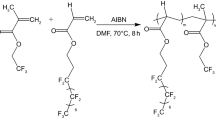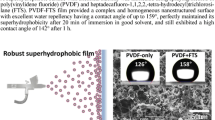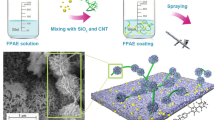Abstract
Polyvinyl chloride (PVDC) coatings require excellent adhesion to substrates. Herein, a series of self-cross-linking silylated polyvinylidene chloride (PVMBV) emulsions with core–shell structure were prepared by seed emulsion polymerization using vinylidene chloride (VDC), methyl acrylate (MA), butyl acrylate (BA), and acrylic acid (AA) as the raw materials. Vinyltrimethoxysilane (VTMO) as the cross-linker was employed to enhance the adhesive properties. The effects of various VTMO contents on the properties of PVMBV were investigated. The results showed that the adhesion performance and thermal stability of PVMBV films were enhanced significantly with the increasing VTMO content. More interestingly, the introduction of a small quantity of VTMO enhanced the toughness of PVMBV films. The water contact angle increased could prove that the hydrophobicity of PVMBV films was improved. Further, it is important to that barrier properties of PVMBV films were effectively improved when VTMO content was no more than 3 wt%. This work provides potential applications in multifunctional barrier coatings, such as vapor barrier, water barrier, weathering, and corrosion protection.














Similar content being viewed by others
References
Ben HJ, Ji CQ, Cheng F, Cui WZ, Chen Y (2014) Water-borne core-shell latexes of acrylate–vinylidene chloride copolymers: preparation, characterization and their anticorrosive properties. Ind Eng Chem Res 53(44):17362–17369
Hwang T, Pu L, Kim SW, Oh YS, Nam JD (2009) Synthesis and barrier properties of poly (vinylidene chloride-co-acrylonitrile)/SiO2 hybrid composites by sol–gel process. J Membrane Sci 345:90–96.
Zhao F, Yin Y, Zhang D, Ning P, Fu M, Yao D, Peng X (2017) Preparation and characterization of novel thermal-stable vinylidene chloride–methyl acrylate–glycidyl methacrylate copolymer. Int J Polym Anal Charact 22(4):338–347
Ma Y, Xie X, Yang W, Yu Z, Du WJAC (2021) Recent advances in transition metal oxides with different dimensions as electrodes for high-performance supercapacitors. Adv Compos Hybrid Mater 4:906–924
Penzel E, Haberkorn H, Heilig JC (1999) Some properties of copolymers of vinylidene chloride with acrylates and methacrylates, Part 1. Die Angewandte Makromolekulare Chemie 273(1):15–27
Hsieh T-H, Ho K-S (1999) Effects of thermal stability on the crystallization behavior of poly (vinylidene chloride). J Polym Sci A 37(16):3269–3276
Hsieh T-H (1999) Effects of oxygen on thermal dehydrochlorination of poly (vinylidene chloride). Polymer J 31(1):948–954.
Abushihada AM, Shunbo FE, Al-Sultan YY (1979) Thermodynamic interactions of polypropylene, poly (vinylidene chloride), sulphonyldiphenyl formaldehyde resin and poly (vinyl pyrrolidone) as stationary phases in GLC with some selected solvents. J Sep Sci 2(1):27–30
Kodani T, Sakai H, And TO, Nomura M (1998) Effect of vinylidene chloride content on film-formation property of vinylidene chloride-methyl acrylate copolymer latex. J Appl Polym Sci 69(1):565–572
Collins S, Yoda K, Anazawa N, Birkinshaw C (1999) Thermal stability of some vinylidene chloride copolymers. Polym Degrad Stab 66(1):87–94
Fu C, Zhang TX, Cheng F, Cui WZ, Chen Y (2014) Double-layer coating films prepared from water-borne latexes of acrylate–vinylidene chloride copolymers: investigating their heavy-duty anticorrosive properties. Ind Eng Chem Res 53(12):4534–4543.
Bie M, Yang J, Yin XD, Bao YZ (2016) Micellization Behavior of Poly (vinylidene chloride-methyl acrylate)-b-Poly (acrylic acid) block copolymers. Acta Polym Sinica 04:443–448
Landes BG, Raich WJ, De Lassus PT, Harrison IR (1983) Thermal behavior of vinylidene chloride—methyl acrylate copolymers. J Macromolecular Sci Part B 22(5–6):747–762
Wang YX, Li C, Zhang XP, Lin QQ, Jiang Y, Yuan JF, Pan MW (2020) Poly (vinylidene chloride)/Poly (chlorotrifluoroethylene-co-acrylates) composite latex coating cured at room temperature showing an excellent corrosion resistance. Chem Select 5(21):6278–6284
Hou C, Wang B, Murugadoss V, Vupputuri S, Du W (2020) Recent advances in Co3O4 as anode materials for high-performance lithium-ion batteries. Eng Sci 11:19–30
Fu H, Xiao Y, Li P, Qian W, Li D, Zhao X, He D (2021) Ultrasonic-assisted soldering for graphite films as heat sinks with durably superior heat dissipating efficiency. Adv Compos Hybrid Mater, pp 1–9.
Farzanfar J, Farjadian F, Roointan A, Mohammadi-Samani S, Tayebi LJ (2021) Assessment of pH responsive delivery of methotrexate based on PHEMA-st-PEG-DA nanohydrogels. Macromolecular Res 29(1):54–61.
Sun J, Shi L, Song T, Sun C (2021) Flame resistance of cotton fabric finishing with N-hydroxymethylacrylamide spirophosphate. Adv Compos Hybrid Mater 4(4):1155–1165
Khan SH, Pathak B, Fulekar MHJ (2020) A study on the influence of metal (Fe, Bi, and Ag) doping on structural, optical, and antimicrobial activity of ZnO nanostructures. Adv Compos Hybrid Mater 3:551–569
Wu NN, Zhao BB, Liu JY, Li YL, Chen YB, Chen L, Wang M, Guo ZH (2021) MOF-derived porous hollow Ni/C composites with optimized impedance matching as lightweight microwave absorption materials. Adv Compos Hybrid Mater 4(3):07–715
Xiao L, Qi H, Qu K, Shi C, Cheng Y, Sun Z, Yuan B, Huang Z, Pan D (2021) Layer-by-layer assembled free-standing and flexible nanocellulose/porous Co3O4 polyhedron hybrid film as supercapacitor electrodes. Adv Compos Hybrid Mater 4(2):306–316
Zhang K, Ma Z, Deng H (2022) Improving high-temperature energy storage performance of PI dielectric capacitor films through boron nitride interlayer. Adv Compos Hybrid Mater 5(1):238–249
Wu X, Wu F (2021) Strong nonreciprocal radiation in a InAs film by critical coupling with a dielectric grating. ES Energy Environ 13:8–12
Li J, Tang XG, Liu QX, Jiang YP, Li WH (2022) Enhancement of the photoelectric properties of composite oxide TiO2 -SrTiO3 thin films. Adv Compos Hybrid Mater 5:1557–1565
Cheng H, Pan Y, Chen Q, Che R, Liu XJ (2021) Ultrathin flexible poly (vinylidene fluoride)/MXene/silver nanowire film with outstanding specific EMI shielding and high heat dissipation. Adv Compos Hybrid Mater 4:505–513
Yan H, Dai X, Ruan K, Zhang S, Gu JJ (2021) Flexible thermally conductive and electrically insulating silicone rubber composite films with BNNS@Al2O3 fillers. Adv Compos Hybrid Mater 4:36–50
Mishra S, Chaudhary P, Yadav BC, Umar A, Dwivedi DK (2021) Fabrication and characterization of an ultrasensitive humidity sensor based on chalcogenide glassy alloy thin films. Eng Sci 15:138–147
Sun J, Mu Q, Kimura H, Murugadoss V, He M, Du W, Hou CJ (2022) Oxidative degradation of phenols and substituted phenols in the water and atmosphere: a review. Adv Compos Hybrid Mater 5:627–640
More APJ (2022) Flax fiber–based polymer composites: a review. Adv Compos Hybrid Mater 5:1–20
Hossain MT, Hossain MS, Uddin MB, Khan RA, Chowdhury AMS (2021) Preparation and characterization of sodium silicate–treated jute-cotton blended polymer–reinforced UPR-based composite: effect of γ-radiation. Adv Compos Hybrid Mater 4:257–264
Xu F, Bao D, Cui Y, Gao Y, Lin D, Wang X, Peng J, Geng H, Wang H (2021) Copper nanoparticle-deposited graphite sheets for highly thermally conductive polymer composites with reduced interfacial thermal resistance. Adv Compos Hybrid Mater, pp 1–12.
Luo X, Yang G (2022) Electrically conductive polymer composite containing hybrid graphene nanoplatelets and carbon nanotubes: synergistic effect and tunable conductivity anisotropy. Adv Compos Hybrid Mater 5:250–262
He X, Ou D, Wu S, Luo Y, Sun JJ (2021) A mini review on factors affecting network in thermally enhanced polymer composites: filler content, shape, size, and tailoring methods. Adv Compos Hybrid Mater 5:21–38
Wang Z, Gao Y, Ma Y, Xie X, Yang M, Zhang HJ (2021) Enhanced electrocaloric effect within a broad temperature range in lead-free polymer composite films by blending the rare-earth doped BaTiO3 nanopowders. Adv Compos Hybrid Mater 4:469–477
Amo BD, Romagnoli R, Deyá C, González J (2002) High performance water-based paints with non-toxic anticorrosive pigments. Progress Organic Coat 45(4):389–397.
Santágata D, Seré P, Elsner CI, Sarli A (1998) Evaluation of the surface treatment effect on the corrosion performance of paint coated carbon steel. Prog Org Coat 33(1):44–54
Yamabe H (1996) Stabilization of the polymer-metal interface. Prog Org Coat 28(1):9–15
Zhai LL, Ling GP, Wang YW (2007) Effect of nano-Al2O3 on adhesion strength of epoxy adhesive and steel. Int J Adhes Adhes 28:23–28
Ge X, Wang M, Ji X, Ge X, Liu H (2009) Effects of concentration of nonionic surfactant and molecular weight of polymers on the morphology of anisotropic polystyrene/poly (methyl methacrylate) composite particles prepared by solvent evaporation method. Colloid Polym Sci 287:819–827
Mills MF, Gilbert RG, Napper DH (1990) Effect of polymerization kinetics on particle morphology in heterogeneous systems. Macromolecules 23(19):4247–4257
Joensson JEL, Hassander H, Jansson LH, Toernell B (1991) Morphology of two-phase polystyrene/poly (methyl methacrylate) latex particles prepared under different polymerization conditions. Macromolecules 24(1):126–131
Yamada Y, Hirai T, Kikuchi R, Hayakawa T, Kakimoto MA (2007) Adsorption of hyperbranched polysiloxysilane modified with triethoxy group onto the silicon wafer. High Perform Polym 19(5–6):700–710
Ji X, Hu Q, Hampsey JE, Qiu X, Gao L, He J, Lu Y (2006) Synthesis and characterization of functionalized mesoporous silica by aerosol-assisted self-assembly. Chem Mater 18(9):2265–2274
Dh A, Cong WA, Bing YA, Xh A, Hx A, Xw A, Sl A, Yang ZB (2021) Investigation of composite silane emulsion modified by in-situ functionalized graphene oxide for cement-based materials. Constr Build Mater 304:124662
Qian X, Zhu A, Ji L (2013) Organosilicone modified styrene-acrylic latex: preparation and application. Polym Bull 70(8):2373–2385
El-Ghaffar MA, Sherif MH, El-Habab AT (2016) Novel high solid content Nano Siliconated poly (VeoVa-acrylate) Terpolymer latex for high performance latex paints. Chem Eng J 301:285–298
Wang X, Zhang C, Xu T, Chen L (2017) Fluoro-silicone modified polyacrylate latex emulsified with green surfactants. J Surfactants Deterg 20(4):905–912
Jiang X, Hu H, Bai Y, Tian X, Huang D, Wang S (2013) Synthesis and properties of the vinyl silicone oil modified polyacrylate core-shell latex as a binder for pigment printing. J Adhes Sci Technol 27(2):154–164
Barquero A, Agirre A, Barandiaran MJ, Leiza JRJEPJ (2019) Monitoring the evolution of the microstructure of vinyl silane monomer containing poly (vinyl acetate) based copolymer latexes during storage. Eur Polymer J 121:109299
Ge X, Zhang Z, Nie J (2005) Preparation and characterization of polysiloxane-polyacrylates composite latices and their film properties. Polym Int 54:861–869
Krimm S, Liang CY (1956) Infrared spectra of high polymers. IV. Polyvinyl chloride, polyvinylidene chloride, and copolymers. J Polymer Sci 22(100):95–112.
Narita S, Ichinohe S, Enomoto S (1959) Infrared spectrum of polyvinylidene chloride. II. J Polymer Sci 37(131):263–271
Wu Y, Zhu C, Chen Z, Qiu H, Liu Y (2020) A type of silicone modified styreneacrylate latex for weatherable coatings with improved mechanical strength and anticorrosive properties. React Funct Polym 148:104484
Yang Y, Li M, Fu SH (2021) Monodispersed colored polymer latex particles with film formation and chemical crosslinking for application on textile binder-free printing. Colloids Surf, A 619:126527
Luo HH, Wei H, Wang L, Gao Q, Chen Y, Xiang J (2022) Anti-smudge and self-cleaning characteristics of waterborne polyurethane coating and its construction. J Colloid Interface Sci 628:1070–1081
Zhang DQ, Yi JM, Zhao F (2021) Transparent and flame retardant vinylidene chloride-methyl acrylate hybrid films with enhanced water vapor barrier, thermostability, and anti-glare properties. J Appl Polym Sci 138(14):50160
Xiao L, Zeng W, Liao G, Yi C, Xu Z (2018) Thermally and chemically stable candle soot superhydrophobic surface with excellent self-cleaning properties in air and oil. ACS Applied Nano Materials 1(3):1204–1211
Ruckenstein E, Li H (1994) The tensile behaviour and toughness of poly (vinylidene chloride)/poly (butyl methacrylate) composites prepared by the concentrated emulsion approach. Polymer 35(20):4343–4348
Barquero A, Leiza JR (2020) Evolution of the film properties of 3‐methacryloxypropyl trimethoxysilane containing waterborne acrylic coatings during storage. J Appl Polymer Sci, 49796.
Delafresnaye L, Dugas P-Y, Dufils P-E, Chaduc I, Vinas J (2017) Synthesis of clay-armored poly (vinylidene chloride-co-methyl acrylate) latexes by Pickering emulsion polymerization and their film-forming properties. Polym Chem 16:6217–6232
Powell E, Clay MJ, Sauntson BJ (1968) The effect of surfactant and copolymer polarity on the film-formation temperatures of some vinylidene chloride copolymers. J Appl Polym Sci 12(7):1765–1773
Zhang L, Zhang C, Li GM (2010) Synthesis and properties of copolymer microemulsions of siloxane and acrylate with a high solid content. J Appl Polym Sci 104(2):851–857
Acknowledgements
This research was supported by grants from the Science and Technology Department of Jilin Province (No. 20220203078SF).
Author information
Authors and Affiliations
Corresponding author
Ethics declarations
Conflict of interest
The authors declare that they have no known competing financial interests or personal relationships that could have appeared to influence the work reported in this paper.
Additional information
Publisher's Note
Springer Nature remains neutral with regard to jurisdictional claims in published maps and institutional affiliations.
Rights and permissions
Springer Nature or its licensor (e.g. a society or other partner) holds exclusive rights to this article under a publishing agreement with the author(s) or other rightsholder(s); author self-archiving of the accepted manuscript version of this article is solely governed by the terms of such publishing agreement and applicable law.
About this article
Cite this article
Li, J., Hong, C., Zhang, H. et al. Fabrication of self-cross-linking silicified polyvinylidene chloride emulsions with core–shell structure and its film properties. Polym. Bull. 81, 1651–1673 (2024). https://doi.org/10.1007/s00289-023-04779-5
Received:
Revised:
Accepted:
Published:
Issue Date:
DOI: https://doi.org/10.1007/s00289-023-04779-5




